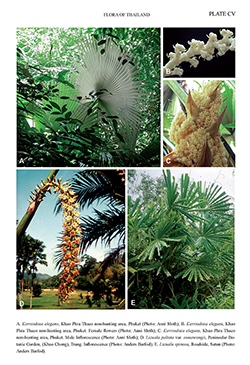e-Flora of Thailand
Volume 11 > Part 3 > Year 2013 > Page 443 > Arecaceae > Licuala
13. Licuala spinosa Thunb.wfo-0000227549
Kongl. Vetensk. Acad. Nya Handl. 3: 287. 1782; Becc. & Hook.f., Fl. Brit. India 6: 431. 1892; Ridl., Fl. Malay Penins. 5: 25. 1925; Gagnep. & Conrard in Fl. Indo-Chine 6: 989. 1937; Furtado, Gard. Bull. Straits Settelements 11: 67. 1940; Saw, Sandakania 10:70. 1997; Barfod & Saw, Kew Bull. 57: 846. 2002. Plate CV: E.
Accepted Name : This is currently accepted.
Synonyms & Citations :
Description : Caespitose palm, with up to 4 m tall stems forming large clumps. Individual stems 4–5 cm diam., ringed by leaf scars. Leaf sheath to 40 cm long, with ligule up to 10 cm long, in younger leaves with dense cover of ferruginous to hyaline ramenta; petiole variable in length up to 2.5 m in fully developed leaves, armed almost to the distal end, armature variable but usually quite noticeable; lamina divided into 15–19 segments, 44–72 cm long; the middle segment sessile or with a petiolule to 6 cm long, with 5–9 adaxial ribs, the remaining ones with 1–3 adaxial ribs, indentations leading to the adaxial folds 1–4 cm long, those leading to the abaxial folds 0.5–1 cm long. Inflorescence 0.9–2.5 m long, extended above the crown, with 5–9 partial inflorescences; peduncle 20–50 cm long, for a large part hidden in prophyll; prophyll 20–30 cm long, covered with patches of ferruginous ramenta; peduncular bracts absent or present; rachis bracts dark green to brown distally, tubular, similar to the prophyll in texture and hair-covering, splitting irregularly into up to 2.5 cm long teeth or disintegrated apically; partial inflorescence inserted 2–6 cm above mouth of subtending bract, covered with dense, puberulent tomentum of simple, ferruginous to hyaline hairs; rachillae 2–7; longest rachilla 20–40 cm long. Flowers up to 200 on one rachilla, solitary or in 2(–3)-flowered cincinni; floral subtending bract to 0.5 mm long, deltoid; buds ca 0.3 cm long; calyx cylindrical to cyathiform, ca 0.3 cm long, covered with adpressed to patent hairs, apex with 0.1–0.13 cm long, obtuse to acuminate lobes; corolla 0.35–0.4 cm long, exposed parts densely covered by seriate hairs arranged in stripes towards the apex, light beige to white on the inside; androecium 0.25–0.3 cm long, staminal ring white 0.1–0.13 cm high, truncate, filaments subulate 0.3–0.4 mm long; anthers ca 0.5 mm long, elliptic; ovary ca 0.1 cm long, glabrous, turbinate, truncate apically, filling little less than half the lumen of the inside flower, locules 0.5–0.6 mm long, basally in each carpel, style slender, filiform, 0.12–0.13 cm long. Fruit globose, ca 0.8 cm diam.
Thailand : All over the country.
Distribution : Widely distributed from Vietnam, the Andaman and Nicobar Islands to Java (type), Borneo and the Philippines.
Ecology : A very common palm distributed in light-open habitats. It is found associated with mangroves where it forms tussocks. It thrives in light-open disturbed habitats such as ditches along roads and dikes separating rice paddies. Finally, it occurs behind the coastline in Peninsular Thailand in forests dominated by Melaleuca cajuputi forests.
Vernacular : Ka pho (กะพ้อ), ka pho ban (กะพ้อบ้าน), ka pho nam (กะพ้อหนาม)(Central); ka pho kiao (กะพ้อเขียว), pho (พ้อ)(Peninsular); ku-wa (กูวา)(Malay-Narathiwat).
Uses: Ornamental.
Conservation Status: This widespread, common species is unlikely to be under threat.
Notes: This species is quite distinct with its clustering habit and hairy flowers. The closest relative is probably the freshwater swamp species Licuala paludosa, which is similar in habit and overall architecture of the inflorescence but has glabrous flowers.

